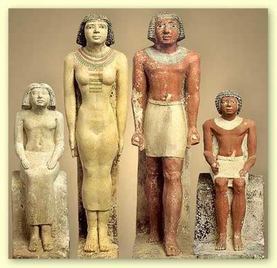Ancient Egypt
Economic Activities
With the access of the Nile River, it provide numerous benefits to the people of the famous civilization. The river encourage the growth and development of many economic activities such as agriculture, fishing, trading, mining, craftsmanship etc. These activities depend on the Nile River for the continuation and development of Ancient Egypt.
Social Society-Way of Life in Ancient Egypt

What are the roles of both male and female in Ancient Egypt?
Most of the Egyptians were peasant farmers. Many were slaves. Men and women spent their days working the soil and repairing the dikes.
Men
Men in Ancient Egypt took on roles such as priests (who served the gods and goddesses), nobles (who fought the Pharaoh's wars), merchants (who organized trading), scribes (who recorded ceremonies, taxes, and gifts, farmers, fishermen, artisans/craftworker (who made fine jewelery, furniture, and fabrics for the palaces and tombs of pharaohs and nobles) and miners.
In the off-season, peasant men were expected to serve the pharaoh by labouring to build palaces, temples, and tombs.
Females
Women's work was not confined to the home.
Females in Ancient Egypt acquired roles such as priestesses, farmers and doctors.Other females manufactured perfumes and textile, managed farming estates
Besides working in the fields, women also spent much time raising children, collecting water, and preparing food-these tasks were similar to those of peasant women today.
Describe the lifestyles of the people in Ancient Egypt.
Religious System
The Ancient Egypt was polytheistic. Polytheistic means the belief in more than one gods.
Identify six gods in Ancient Egypt's religious system
Identify the main role of the priest
What is meant by the term "Mummification"?
Writing Records, Medicine, Science, Painting, Sculpture, Literature-Achievements
Writings
Learned scribes played an integral role in Ancient Egypt. Temple scribes kept records of ceremonies, taxes and gifts. Other scribes served nobles or the pharaoh. Besides learning to read and write, scribes also acquired skills in mathematics, medicine and engineering.
Define the below terms:
Hieroglyphics
Ideograms
Demotic
Medicine
Egyptian physicians believed in various kinds of magic. Their knowledge of mummification had exposed them to the human body. They were skilled in observing symptoms, diagnosing illnesses, and finding cures. Doctors performed complex surgical operations which they describe on papyrus scrolls. They also prescribe medicines such as anise, castor beans and saffron.
Astronomy
Egyptian priest-astronomer studied the heavens, mapping constellations and charting the movements of planets. With this knowledge, they developed a calendar that has 12 months of 30 days each and 5 days added at the end of each year. It is the basis of our modern calendar.
Engineering
Nile floods forced Egyptians to redraw the boundaries each year. The engineer develop practical geometry to survey the land. Geometry was used to calculate the size (exact) and location of ids and each block of stone to be placed in a pyramid. Huge building projects such as pyramids and irrigation systems required considerable skills in design and engineering.
Painting and Sculpture
The arts of Ancient Egypt included statues, wall paintings in tombs and carvings on temples. Some everyday scenes of trade, farming, family life or religious ceremonies. Others boast of victories in battles.
Egyptian Literature
The oldest literature of Ancient Egypt includes hymns and prayers to the gods, proverbs and love poems. Other writings tell of royal victories in battles.
Useful Links: